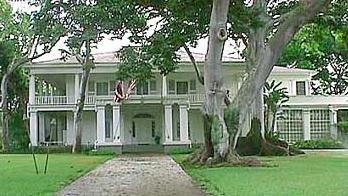

Library Catalog | Bibliographies | Hawaii Documents Center | Links | Newspaper Index | Programs | Yearbooks | Sitemap
 |
 |
Library Catalog | Bibliographies | Hawaii Documents Center | Links | Newspaper Index | Programs | Yearbooks | Sitemap |
|

Hawai‘i is an ancestral name brought across the Pacific by the Polynesians. It seems to have been an original homeland and its meaning no longer is known.
SANDWICH ISLANDSCaptain Cook named the islands he discovered after the Earl of Sandwich, then First Lord of the Admiralty; however, as early as 1818, King Kamehameha I is reported to have protested, stating that each island should be called by its own name and the entire group referred to as the "Islands of the King of Hawai‘i" (Golovnin). "Sandwich islands" continued to be used unofficially for many years, but its use in official communication gradually became obsolete after 1844.
HONOLULUHono means valley with a bay in front of it and -lulu means sheltered. Honolulu variously translates as "fair haven," "quiet harbor" or "sheltered harbor."
WAIKIKIWai means water and -kiki means to spurt, thus it translates as "spurting water."
STATE NICKNAME"The Aloha State" was designated as the official "popular" name for the State of Hawai‘i by Joint Resolution 1, 30th Territorial Legislature, April 23, 1959.
STATE FLAGThe flag of the state is the flag designed prior to 1816 for King Kamehameha I. It has served as the flag of the Kingdom, Republic, Territory and State of Hawai‘i. It consists of eight horizontal stripes (representing the eight islands) that are alternately white, red, and blue, beginning with the top, with the British Union Jack in the upper left corner. The Union Jack might have been included out of consideration for Vancouver who gave the islands their first flag when King Kamehameha I placed the islands under the protection of Great Britain. The state constitution makes it the official state flag.

The flag is divided horizontally into two equal sections - the upper half blue and the lower half red. The center contains the word "HAWAII" in white. "HAWAII" is surrounded by eight equi-distant white stars that represent the eight islands of the Hawaiian group. The flag originally was designed by the adjutant general for the Governor of the Territory. As the flag of the territorial governor, it had "T H" in the center.
STATE SEALThe great seal was designated officially by Act 272 of the 1959 Territorial Legislature and is based on the territorial seal. It is circular and between the outer lines are the words "State of Hawaii Ua mau ke ea o ka aina i ka pono." The year "1959," just within the circle, signifies the date that the state government was organized. The heraldic shield in the center has the figure of King Kamehameha I on the right side and the Goddess of Liberty, who is holding the Hawaiian flag, on the left side. Below the shield is the phoenix, surrounded by taro leaves, banana foliage and sprays of maidenhair fern. With color added, the seal becomes the state coat of arms.

The great seal of the territory of Hawai‘i was the same as the seal of the state, except that it had "Territory of Hawaii" at the top and "1900" (signifying the year that the territorial government officially was organized) within the circle. The seal of the republic had "Republic of Hawaii" at the top and "MDCCXCIV" within the circle. The year "1894" signified the date that the republic was established.
COAT OF ARMS AND SEAL, KINGDOM OF HAWAI‘IThe coat of arms of the kingdom was adopted in May, 1845. As designed originally, it was quartered, with the stripes of the national banner in the first and fourth quarters and the pulo‘ulo‘u (tabu ball and stick) in the second and third. At the center was the ancient triangular flag of Hawaiian chiefs, with two spears crossed. Both the pulo‘ulo‘u and the flag on crossed spears were used to indicate tabu and a place of refuge. Over this central design was a crown. On each side was the figure chief in a feather cloak and a helmet. The one on the left, bearing a spear, was Kamanawa and the one on the right, with a Kahili (feather standard), was Kameeiamoku. These figures, facing inward, are believed to represent the warrior twins who supported King Kamehameha I in his endeavors to unite the islands. Below was the motto of the kingdom, Ua mau ke ea o ka aina i ka pono. Later representations show a feather cape as background. During the period of King Kalakaua, several changes were made: the two figures were faced out rather than in; a Maltese cross was added over the crown and the cross of an undetermined order below that motto; the feather cape became an ermine cape; and the second crown was added over all. There is no evidence that these changes were ever approved officially; however, they appear in the coat of arms used by both King Kalakaua and Queen Lili‘uokalani on official palace invitations and on the 1883 coins.
STATE MOTTOUa mau ke ea o ka aina i ka pono. This motto was given to the kingdom by King Kamehameha III at the time that sovereignty and the flag were restored by the British in 1843. It was made the official motto of the State of Hawai‘i by Joint Resolution 4, 30th Territorial Legislature, May 1, 1959. The official translation is "The life of the land is perpetuated in righteousness."
STATE BIRDThe nene or Hawaiian goose (Branta sandvicensis) was adopted as the bird emblematic of the Territory of Hawai‘i by House Concurrent Resolution 52, 29th Territorial Legislature, May 7, 1957. By Act 178, Session Laws of Hawaii 1988, the Nene was established and designated as the official bird of the State.

Act 9, Session Laws of Hawaii 1987, states, "The black coral is established and designated as the official gem of the State."
STATE TREEThe kukui or candlenut tree (Aleurites moluccana) was designed as the official state tree by Joint Resolution 3, 30th Territorial Legislature, May 1, 1959. The coconut palm or niu (Cocos nucifera) had been the official tree of the Territory of Hawai‘i, having been so designated by proclamation of Governor Lawrence Judd on March 17, 1930.
STATE FLOWERThe pua aloalo (hibiscus) was designated as the flower emblem of Hawai‘i by Joint Resolution 1 of the 1923 Territorial Legislature. It continues as the official flower of the State of Hawai‘i, since all territorial laws continue in force. The act did not specify any particular color, but referred to it as an indigenous blossom, having a variety of color and form. At the same time, official flowers and colors were established for each of the islands. The question of an official color for the state flower was taken care of through the passage of Act 177, Session Laws of Hawai‘i 1988, which reads: "The native yellow hibiscus (Hibiscus brackenridgei A. Gray), also known as the Pua Aloalo or Ma‘o-hauhele, is established and designated as the official flower of the State."

| Table of Hawaiian Island Colors & Flowers | |||
| Island | Island Nickname | Color | Flora |
| Hawai‘i | The Big Isle | Red | Pua Lehua (‘Ohi‘a blossom, Metrosideros collina polymorpha) |
| Maui | The Valley Isle | Pink | Lokelani (Small rose) |
| O‘ahu | The Gathering Place | Yellow | Pua ‘Ilima (Sida fallax) |
| Kaua‘i | The Garden Isle | Purple | Mokihana (fruit capsule of small native tree of the citrus family, Rutaceae Pelea anisata) |
| Moloka‘i | The Friendly Isle | Silvery Green | Pua Kukui (Candlenut tree, Aleurites moluccana) |
| Lana‘i | The Pineapple Isle | Orange | Kauna‘oa (Native dodder Cuscuta sandwichiana) |
| Ni‘ihau | The Distant Isle | White | Pupu (Small shells) |
| Kaho‘olawe | The Forbidden Isle | Gray | Hinahina (Native heliotrope, Heliotropium anomalum var. argenteum) |
|
Sources: Neal, Marie C. In Gardens of Hawaii. Hon., HI : Bishop Museum Press, 1965, p.xvi. Joint Resolution 1, Session Laws of Hawaii, 1923. |
|||
Honolulu has been the capital city of the Hawaiian Islands since February, 1845, when King Kamehameha III made it his permanent residence. Before this, Kailua, in the Kona district of Hawai‘i, and Lahaina, Maui, as well as Honolulu, had been the residences of the rulers. King Kamehameha III lived primarily in Lahaina before 1845, and it was there that the Legislature and Supreme Court met between 1840 and 1844. A resolution of the Privy Council on August 30, 1850, officially declared Honolulu a city and the capital of the Hawaiian Islands. The constitution designates Honolulu as the capital of the state.
STATE CAPITOLThe Hawai‘i State Capitol, located on Hotel and Beretania streets, houses the governor, the lieutenant governor, several state government departments and the state Legislature. It was designed by Belt, Lemmon and Lo and John Carl Wernecke and Associates and dedicated in 1969.
Until then, the seat of government was at ‘Iolani Palace, built by King Kalakaua in 1882 and used as his official residence. ‘Iolani Palace was used by both King Kalakaua and Queen Lili‘uokalani. The Provisional Government, established on January 17, 1893, took possession of the building and officially designated it as the Executive Building on June 3, 1893. The name "‘Iolani Palace" was restored in 1935.

This is the official residence of the governor of the state. The house originally was built in 1846 by Captain John Dominis. It was named "Washington Place" in 1847 by Anthony Ten Eyck, the American commissioner who established the United States Legation in part of the building. It became the property of Queen Lili‘uokalani upon the death of her husband, John O. Dominis, the son of the original owner. The 1919 Legislature authorized its purchase by the territory. It was first occupied as the Executive Mansion in 1922 by Governor Wallace Farrington.

Hawai‘i Pono‘i
Words by King David Kalakaua
Music by Prof. Henry Berger
Note: this version of the song is not in the printed bibliography. It comes from He mele aloha: a Hawaiian songbook, compiled by Carol Wilcox. 2003. Call number H 787.89164 He.
Hawai‘i pono‘i
Nana i kou, mo‘i
Ka lani ali‘i
Ke ali‘i
hui
Makua lani e
Kamehameha e
Na kaua e pale
Me ka ihe
Hawai‘i pono‘i
Nana i na ali‘i
Na pua muli kou
Na poki‘i
Hawai‘i pono‘i
E ka lahui e
‘O kau hana nui
E ui e
Translation
Hawai‘i's own
Be loyal to your chief
Your country's liege and lord
The ali‘i
chorus
Father above us all
Kamehameha
Who guarded in war
With his spear
Hawai‘i's own
Look to your lineal chiefs
These chiefs of latter birth
Younger siblings
Hawai‘i's own
People of loyal hearts
Thy only duty lies
Listen and abide
